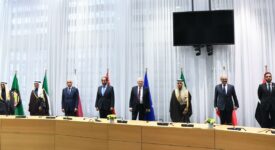Although NATO stated that Europe’s security wasn’t linked to the stability of its neighboring countries, the Allied leaders made it clear that the opposite was the case – that the security of the organization was indeed connected closely to the stability in its vicinity. This was not just an aspiration but also a conclusion drawn in light of the most recent developments in NATO’s neighborhood. The experience in Ukraine, Iraq and Syria has shown that what’s going on in the Alliance’s neighborhood has profound implications for the security of NATO’s own citizens.
In response to this acknowledgment came a commitment to do something about it. At the latest NATO summit in Warsaw, the Allies signed for an agenda called “Project Stability” that outlines measures for the Alliance to address the instability in its neighborhood. The document is seen as a comprehensive tool to run partnerships with the key states, support capacity building and boost crisis management. By committing themselves to ‘projecting stability’, NATO emphasized that despite the worsening security conditions, the Alliance is not shying away from its holistic view on security. There is also a push for the Alliance to evolve so that “NATO has a long-term and sustainable approach to projecting stability with adequate and sustainable resources and structures, making best use of existing funding mechanisms.”
Overall, there is an increasing emphasis on the “southern neighborhood”, somewhat in contrast to the traditional focus on NATO’s “eastern neighborhood”, namely Central and Eastern Europe, the Western Balkans and the former Soviet Union. Yet, since the Arab Spring, the Alliance has seen a piecemeal but steady increase in work with its Middle East and North Africa allies, complementing its work with the Eastern partners. In specific cases, NATO has focused on its partnerships with the South, especially on building institutions and defense capabilities. The Warsaw summit further advanced these efforts by launching a new training and capacity building center in Iraq.
Moving forward, NATO will need to work further on projecting stability. Three strategies, in particular, should be focused on: exploiting and developing networks; partnering with the European Union; and deepening the use of voluntary financial contributions. First, NATO’s partnerships demonstrate that networks can be leveraged in many ways. Many of NATO’s programs attract a wide range of voluntary donations that multiply what NATO’s common budget invests. Moreover, NATO staff is able to draw on expertise, network and experience to conduct mentoring, advice and training.
Second, the potential for deeper partnership with the Alliance’s key strategic partners – mainly the European Union – should be leveraged. The two organizations share common ground, a common commitment to the resilience and work together on the core areas of deeper cooperation identified in Warsaw. Utilizing this expertise and financial resources would be a significant way to boost a “networked” approach to “projected stability”. Finally, both NATO and the EU need to make sure that the current financing arrangement is ready to deal with the potentially higher support in the future. Currently, the funds generate more funds than what is available on annual basis so it is essential that this tool is able to absorb more resources down the line.
As the Alliance is getting ready for the 2018 summit, it needs to ensure that it is ready to face the challenge of actually making “Projecting Stability” happen. However, NATO can build on the significant progress made since Warsaw, particularly when it comes to defining the role of partnerships and capacity building.
‘Projecting Stability: An Agenda for Action’ – Analysis by Ruben Díaz-Plaja – NATO Review Magazine.







